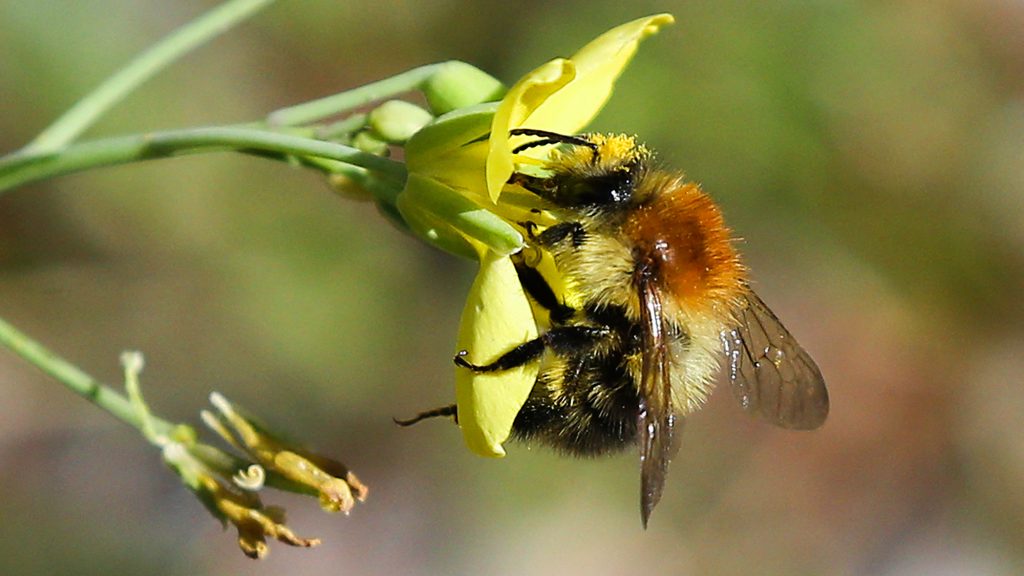Invasive plants dramatically alter their environment, and the dwindling number of insect pollinators is forced to suffer new disasters: they behave like the fox and stork in La Fontaine’s fairy tale.
For a long time, science has been sounding every alarm bell, warning of the widespread and rapid destruction of insect pollinators, because without them, agricultural production would eventually be in jeopardy. When it comes to pollinators, obviously everyone thinks of the honeybee, and though they make up the most populous group, they’re still just the tip of the iceberg: They do their thing with 700 wild “species,” masses of butterflies, Mosquitoes and flies, thousands of species in total – we wrote about this in detail here.
There are many reasons why it is so diminishing, from climate change to reduced biodiversity to environmental pollution, and the common denominator is that practically all problems are caused by human activity. It also belongs to this circle, but the impact of invasive plants and non-native insects on each other is relatively unknown in the public consciousness.
the Environmental Research Centre (ÖK) and colleagues survey flooded and landscaped communities in which they investigated the impact of 12 invasive herbaceous plant species in Hungary, and With Babis-Bolyai University Collaboration in Transylvania. about their results Dr. Victor Zigetiwe asked the scientific colleague of ÖK.
dynamic balance
As mentioned, the so-called plant pollination systems play a very important role in most terrestrial ecosystems, a concept that includes not only insects that transmit plant gametes.
Let’s imagine a meadow preserved in a condition as close to natural as possible. The vegetation consists of countless herbs, from spring to autumn we can always find species whose flowers are just opening. In this environment, crowds of bees, flies and butterflies feed during the entire vegetation period – it is clear that it is not noticeable to the layman, but the company often changes. locally there are always those species in the majority that are best adapted to the type of flower currently available.
While they feed, pollinators ensure the reproduction of flowering plants. If they find enough food, they can reproduce and attend the following year, as well as the new generation of plants that live with their help. This maintains the long-term dynamic balance between plants and pollinators
Victor Zigeti says to 24.
The greater the number of plant species, the greater the diversity of the insect world, and the essence of the stability of the system is diversity, that is, in a slightly simplified way, species richness. However, when non-native plant species begin to spread vigorously, they are able to completely cover the designated area, and thus the habitat itself becomes more homogeneous.
It makes everything around you disappear
In the extreme case, it could theoretically happen that the flowers of only one plant species are available in the flooded field, and by definition only during the few days or weeks of flowering of the species. Thus, even temporary food can only be found by insects “compatible” with the particular flower, but the area becomes a green desert for them during the period before and after flowering.
Fortunately, the domain of a single species is just an example to illustrate the dangers inherent in reducing diversity, but let’s say a non-native goldenrod can dominate a portion of a landscape up to 90 percent, but other species can also occupy 40-50 percent. from a specific country.
A plant’s pollination system is full of specialists, which means the aforementioned compatibility is just as important as the time frame in which food is available. Specialists have examined many characteristics of plants and pollinators, from flowering time, through flower color to depth, but for the sake of clarity, let’s stick to the last.
Butterfly and fly like stork and fox
Most pollinators look for nectar, which collects at the base of the flower, so only insects with long mouthparts, such as butterflies, have access to a deep, hollow flower. In this case, the nectar is thinner and easier to suck.
The nectar of flat flowers is usually thicker, butterflies do not thrive on it, but, for example, hummingbirds or bumblebees – bees somewhere in the middle in terms of the size of the oral organ – easily lick it with their tongues. We kind of fantasize about it like La Fontaine In the story of the stork and the fox, as the stork could not eat from the flat plate of Ravached, so he took revenge the next day with a dinner served in a long-necked dish, so both remained hungry as the guest of the other.
According to the research findings, apart from some general patterns, the 12 invasive species examined do not have a mutual effect: like many invasive plant species and their characteristics, they can have many different effects on flooded plants and pollinator communities. Staying with the above, for example, in the presence of invasive plant species with deep blooms, we find more long-tongued wild bees with larger body size. The reverse is also true, in the case of invasive species with shallower flowers, there are more bees with smaller stature.
It is recommended to delete after consideration
Therefore the invasion of a particular plant characteristic greatly influences the composition of the insect community that can survive in the flooded area. It is also true for pollinators that non-native plants reduce biodiversity and homogenize landscapes, so taking action against these plant species is also important from the point of view of protecting pollinators. However, the expert highlights:
Some invasive plants can provide important food for rare, even protected, pollinating insects, so eliminating them by all means may not be the best solution.
Instead, Viktor Szigeti suggests, they should be taken into account by species, location, and specific situation. When suppressing non-native species, it is also worth considering and supplementing the nutritional needs of pollinators with, for example, sowing a native seed mixture.












































